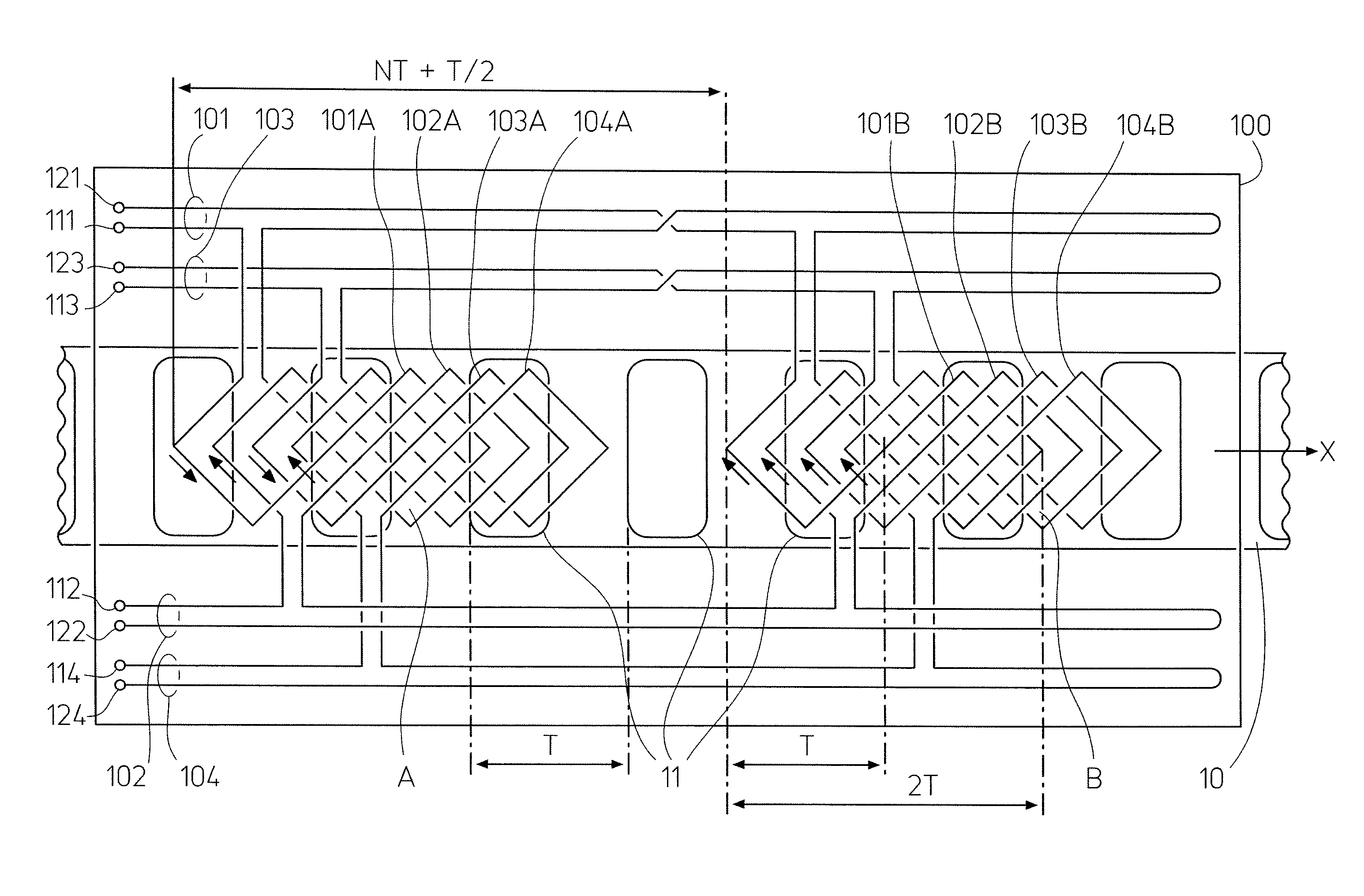Inductive position sensor
a position sensor and inductive technology, applied in the direction of instruments, measuring devices, coils, etc., can solve the problems of causing measuring distortion by the same magnetic field, and achieve the effects of smoothing out distortion, reducing gap, and weak coupling via the scal
- Summary
- Abstract
- Description
- Claims
- Application Information
AI Technical Summary
Benefits of technology
Problems solved by technology
Method used
Image
Examples
first embodiment
[0016]a sensor according to the invention is shown in FIG. 1. The sensor consists of a flat scale 10 relatively movable along a path x under a flat reading head 100 with four windings 101, 102, 103, 104 shown in transparency, as they are on or near the side facing the scale, i.e. under reading head 100 as seen from above. The scale 10 has a spatially periodic series of conducting screens 11, of spatial period T along path x, i.e. along the scale.
[0017]Each winding 101, 102, 103, 104 is divided in two separate identical winding elements facing the scale 10, respectively 101A and 101B, 102A and 102B, 103A and 103B, 104A and 10413. Winding elements 101A, 102A, 103A, 104A, shifted from each other by T / 4, are interlaced together in a first winding element pattern A, and winding elements 101B, 102B, 103B, 104B, shifted from each other by T / 4, are interlaced together in a second winding element pattern B, identical to the first. Pattern B is shifted from pattern A by NT+T / 2, N being an int...
second embodiment
[0032]a sensor according to the invention is shown in FIG. 2. The sensor consists of a scale 20 movable along a path x under a reading head (outline not shown) with four windings 201, 202, 203, 204 lying on or near the side facing the scale. The flat ladder-like scale 20 is conducting and has a spatially periodic series of openings 22 with a spatial period T along the path x, i.e. along the scale.
[0033]Each winding 201, 202, 203, 204 is divided in two separate identical winding elements facing the scale 20, respectively winding elements 201C and 201D, winding elements 202C and 202D, winding elements 203C and 203D, and winding elements 204C and 204D. Winding elements 201C, 202C, 203C, 204C, shifted from each other along the scale by T / 4, are interlaced by pairs in a winding element pattern C, and winding elements 201D, 202D, 203D, 204D, shifted from each other along the scale by T / 4, are interlaced by pairs in a winding element pattern D identical to pattern C. Both patterns C and D ...
PUM
| Property | Measurement | Unit |
|---|---|---|
| drive current | aaaaa | aaaaa |
| shape | aaaaa | aaaaa |
| center-to-center distance | aaaaa | aaaaa |
Abstract
Description
Claims
Application Information
 Login to View More
Login to View More - R&D
- Intellectual Property
- Life Sciences
- Materials
- Tech Scout
- Unparalleled Data Quality
- Higher Quality Content
- 60% Fewer Hallucinations
Browse by: Latest US Patents, China's latest patents, Technical Efficacy Thesaurus, Application Domain, Technology Topic, Popular Technical Reports.
© 2025 PatSnap. All rights reserved.Legal|Privacy policy|Modern Slavery Act Transparency Statement|Sitemap|About US| Contact US: help@patsnap.com



